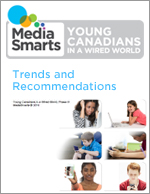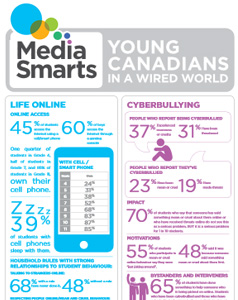Young Canadians in a Wired World, Phase III: Trends and Recommendations
 This is the final report in a series of nine from the Young Canadian in a Wired World: Phase III study. The Trends and Recommendations report brings together the findings from interviews with children, teens, parents and teachers and a national survey of students in grades 4 to 11, which took place between 2012 and 2013. It offers recommendations for parents, teachers and policy makers to support young people in meeting the challenges of growing up in the digital age. It also includes an analysis of students’ top 50 favourite websites and profiles of students’ online activities organized by grade.
This is the final report in a series of nine from the Young Canadian in a Wired World: Phase III study. The Trends and Recommendations report brings together the findings from interviews with children, teens, parents and teachers and a national survey of students in grades 4 to 11, which took place between 2012 and 2013. It offers recommendations for parents, teachers and policy makers to support young people in meeting the challenges of growing up in the digital age. It also includes an analysis of students’ top 50 favourite websites and profiles of students’ online activities organized by grade.
Report:
Full Report (PDF)
List of Top 50 Websites (PDF)
Profiles by Grade:
- All Profiles by Grade 4 -11 (PDF)
- Profile by Grade 4 - 5 (PDF)
- Profile by Grade 6 - 7 (PDF)
- Profile by Grade 8 - 9 (PDF)
- Profile by Grade 10 - 11 (PDF)
Young Canadians in a Wired World, Phase III: Trends and Recommendations was made possible by financial contributions from the Canadian Internet Registration Authority, the Office of the Privacy Commissioner of Canada and The Alberta Teachers’ Association.
Young Canadians in a Wired World, Phase III Infographic
Share the Young Canadians in a Wired World, Phase III infographic using the share icons above, tweeting using the hashtag #YCWW, and posting the infographic on your website using the embed code below.
To view the full infographic click this image.
Share this infographic image on your site
About Young Canadians in a Wired World
Initiated in 2000 by MediaSmarts, Young Canadians in a Wired World (YCWW) is the most comprehensive and wide-ranging study of children’s and teens’ Internet use in Canada. Phase I and Phase II of this ongoing research project – which tracks and investigates the behaviours, attitudes and opinions of Canadian children and youth with respect to their use of the Internet – were conducted in 2001 and 2005. In 2011, MediaSmarts launched Phase III of the YCWW study with qualitative research comprising interviews with teachers from across Canada and focus groups with children and youth and parents, followed by a national classroom survey in 2013.

